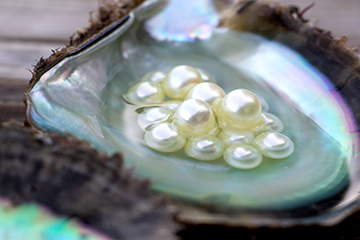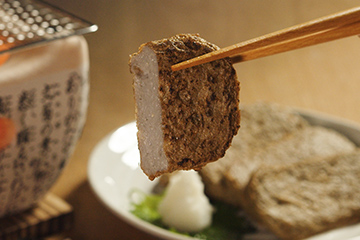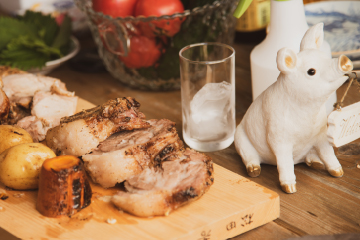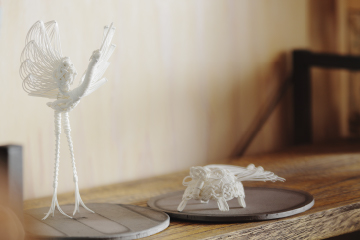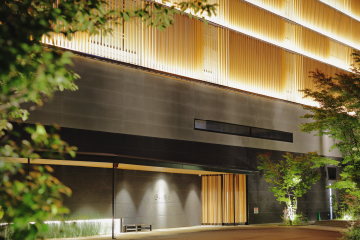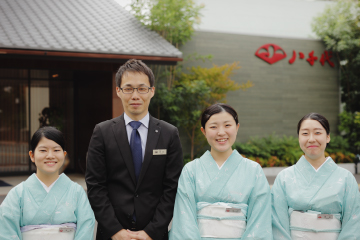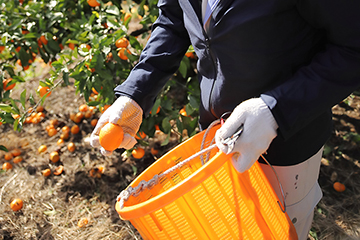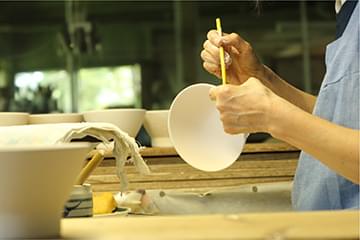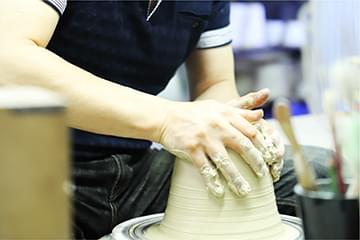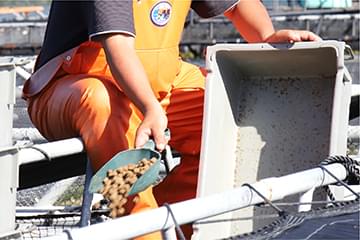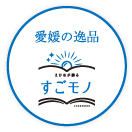Pearls from Ehime Prefecture
From Japan’s No. 1 pearl cultivation area, offering unwavering quality and new value.

A miracle grain crystallized from the blessings of the Uwa Sea and the love of the pearl cultivators.
“The pearl cultivation in Ehime Prefecture is the result of the rich natural resources of the Uwa Sea and craftsmanship,” says Mr. Maki Kasu, General Manager of the Ehime Prefectural Fisheries Cooperative Association. The coast of the Uwa Sea, where Ehime pearls are cultivated, is a rias coast with complex inlets. In addition to the calm waves and easy management of oysters, the warm water temperature from the Kuroshio Current and the nutrient-rich seawater flowing into the sea, known as the bottom tide, provide the perfect environment for cultivating pearls. There is an abundance of diatoms which are good food for the Akoya pearls. It is the skill of the crafsmen who cultivate Akoya pearls that brings out the best of this geographical advantage to create pearls that are reputed to be larger than those of other regions and have an absorbing brilliance. The most difficult part of the process is called “nucleation,” in which the nucleus or the source of the pearl, is placed inside the mother oyster. The process of inserting a scalpel into the ovary of the mother oyster, instantly select and insert a pearl nucleus suitable for the size of the oyster is like an advanced surgical operation. Only a craftsman with many years of experience can do this. After the pearl nuclei have been prepared over a period of four months from spring to summer, the mother oysters are lovingly cultivated, either in a cage to rest in the quiet sea or in an offshore location with strong tidal currents, depending on their growth.

Nucleated mother oysters are cultured in the sea for more than six months until the following winter, when the pearls are extracted.

While carefully observing changes in water temperature and quality, the depth at which the baskets containing shellfish are hung is finely adjusted, and the baskets are painstakingly cleaned to prevent seaweed and other debris from sticking to them.

The “Ehime Method,” the best production system in Japan, produces a fresh brilliance.
The greatest feature of pearl cultivation in Ehime Prefecture is that it starts from the production of mother oysters. The production of mother oysters, which are the mother of all beautiful pearls, requires specialized techniques that differ from pearl cultivation, as well as one to two years of labor and effort. Ehime Prefecture, which has been cultivating pearls since 1907, has a 90% share of the domestic production of mother-of-pearl oysters, thanks to the techniques it has developed over its long history. The pearl oysters are not only used for pearl cultivation in the prefecture but are also sold to pearl suppliers all over Japan. The production of mother oysters and the cultivation of pearls using them, two processes that are carried out in parallel in one area, is called the “Ehime Method” and is a rare production system in Japan. The environment in which mother oysters and pearl producers work in the same area and can exchange opinions constantly is the driving force behind the high quality of pearls produced in Ehime. Mr. Kasu says,“It takes more than three years to cultivate pearls in Ehime Prefecture, counting from the time the mother oysters are made, but only about 10% of them are certified as first-class products. But only about 10% of them are certified as first-grade pearls.” Surprisingly, only 60% of all pearls are sold.

“Good quality Akoya pearls have a fresh brilliance,” says Mr. Kasu. His unique expression conveys the charm of pearls, which are said to be the world’s only jewels made by living creatures.

Only high-quality pearls are carefully selected based on various indicators such as shape, shine (brilliance), curling (thickness of the nacreous layer), and absence of flaws.

“miu”, a pearl brand from Uwajima, offers unique designs that can be enjoyed casually.
Fascinated by the beauty of pearls produced in Ehime Prefecture, Mr. and Mrs. Hashimoto, who run an engraving studio in Uwajima City, launched their own brand of pearl accessories. They named their brand “miu,” an acronym for “Made in Uwajima”. “It is said that seven different colors of light can be seen in a single pearl. Among them, Akoya pearls have the finest texture and most beautiful luster in the world. I think they are delicate jewels that match the sensibilities of the Japanese people,” said Mrs. Erika Hashimoto. Pearls are generally associated with formal occasions, such as weddings and funerals, but the miu lineup overturns this stereotype. In particular, the pinky ring, which started as a collaboration with Uwajima City, is a popular product that has won numerous awards, including the Ehime Prefecture Prize at the Japan Gift Awards and The Wonder 500 selected by the Ministry of Economy, Trade and Industry. “Ehime pearls are beautifully harmonized with the warm design of nature motifs such as four-leaf clovers and ladybugs. Every time the design motif or the shape of the pearl’s changes, I have to try a new process, which is both difficult and fun,” says Mr. Akatsuki Hashimoto, who is in charge of metal engraving. They are pioneering a new world of pearl jewelry that can be enjoyed casually with designs that make the most of the individuality of each pearl, which is said to be impossible to make the same because they are made by living creatures.

Akatsuki, who used to work in the metal carving department of a pearl processing cooperative in Uwajima, and Erika, who is from Hyogo Prefecture and used to work at a glass studio. Erika says that she was not interested in pearls to begin with, but the moment she saw Ehime pearls up close, she was drawn in by their beauty.

Another advantage of a workshop based in a pearl production area is that you can obtain not only perfect spheres, but also many very small pearls called baroque pearls and keshi pearls, each of which has a unique shape. The pearls with horn-like sharp projections are designed to look like the stingers of bees.

Premium jewelry “HIME PEARL” made from pearls produced 100% in Ehime Prefecture.
The pearl industry has not yet built a traceability system and it is said that once pearls are put on the market, the place of origin becomes unknown. The Ehime Fisheries Cooperative Association launched the original brand “HIME PEARL” using pearls produced 100% in Ehime Prefecture with the support of the prefectural government, in order to deliver jewelry using only high-quality pearls selected under strict quality standards. The pearls used in this brand are particular about the thickness of the nacreous layer, called “maki”. “We also cultivate pearls called ‘koshimono,’ which take twice as long to grow as normal pearls, in order to obtain the profound brilliance that only beautifully wound nacreous layers can give off,” says Mr. Kasu. In order to objectively evaluate the thickness of the pearl’s curls and communicate it to customers, each pearl is measured by a special machine, and rare pearls with a thickness of 0.7mm or more per side are named “PREMIUM”.

The HIME PEARL brand conducts thorough quality control so much so that they even know which company cultured which pearl.

“A really good pearl has a variety of colors and shine depending on the angle and the light, so you will never get tired of looking at it,” said Mr. Kasu, manager of the Ehime Fisheries Cooperative Association.

Introducing a new way to enjoy pearls through collaborations with traditional materials.
The culture of enjoying pearls daily is taking root in Ehime Prefecture, with the city of Uwajima promoting a movement called “Pearl Biz,” which is like “Cool Biz”. Erika Hashimoto of Akatsuki Kobo also speaks of the appeal of pearl jewelry for daily use, saying, “Wearing pearls always makes me feel dignified and cheerful.” The pearl pin brooch “Kumihimo” was developed by Akatsuki Kobo in collaboration with “Shoen Kumihimo” in Uji City, Kyoto. The design, which can be worn by both men and women in a wide range of situations, is a gem that won the “21st Century Ehime Traditional Craft Award”. In addition, a bracelet that can be worn as easily as a misanga with pearls, which have a long tradition of protecting against disasters, was developed to bring cheer to daily life amidst the COVID-19 pandemic. Both products use baroque pearls with unique shapes and colors that are different from perfect circles, and only the best ones are selected for their high quality and suitability for the design. These products are perfect for those who want to enjoy accessories with a sense of fun, or for those who feel pearl jewelry is too expensive to start wearing pearls.
-
![]() miu Pearl Pin Brooch
miu Pearl Pin Brooch“The idea for the pearl pin brooch Kumihimo came when I attended a meeting on the development of prefectural products and saw the beautiful braided cord that the male advisor in charge was wearing around his wrist. The elegant luster of the silk goes perfectly with the pearls and looks great with suits and casual wear.”
-
![]() miu Pearl Amulet Bracelet
miu Pearl Amulet BraceletThe pearl bracelet was sold as a set with an “amabie” postcard in collaboration with “Ikazaki Shachu,” a local company that manufactures and sells Japanese paper wallpaper in Ehime Prefecture. “The charm of pearls is that they are surprisingly durable. I wear them all the time, even when I’m taking a bath or sleeping,” says Erika Hashimoto of the Akatsuki Kobo.
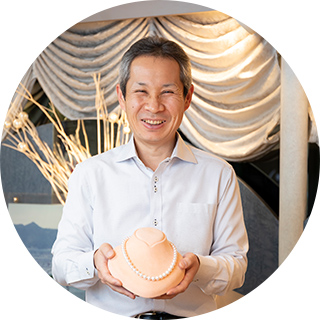 Maki Kasu, Direct Sales General Manager and Shinju Manager
Maki Kasu, Direct Sales General Manager and Shinju ManagerTel: 089-933-8879 Fax: 089-921-3964
 Akatsuki and Erika Hashimoto
Akatsuki and Erika Hashimoto









